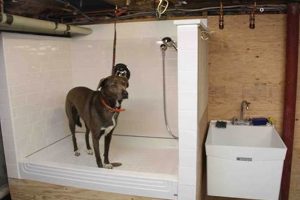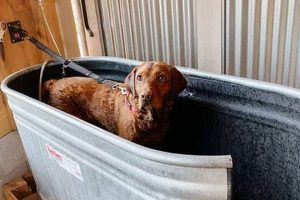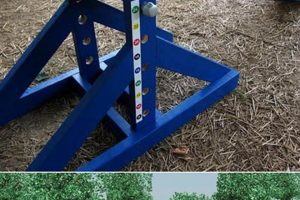The concept involves the construction of canine sleeping platforms utilizing wood as the primary material, and emphasizes a do-it-yourself approach. An example would be building a customized pet resting area from repurposed pallets, tailoring dimensions to suit the animal’s size.
Such projects provide opportunities for cost-effective pet care solutions and encourage sustainable practices through material reuse. Historically, homemade animal shelters have been a common practice, evolving from basic necessities to increasingly sophisticated designs that cater to both animal comfort and owner aesthetics.
The following sections will explore various design considerations, essential tools and materials, and step-by-step instructions for creating durable and aesthetically pleasing resting places for canine companions.
Considerations for Constructing Custom Canine Resting Platforms
Successful creation of personalized canine sleeping spaces requires careful planning and execution. The following guidance provides key considerations for ensuring structural integrity, pet safety, and aesthetic appeal.
Tip 1: Material Selection: Opt for hardwoods or pressure-treated lumber for enhanced durability, particularly for larger breeds. Untreated softwoods are suitable for indoor use with smaller dogs.
Tip 2: Joint Construction: Employ robust joinery techniques such as mortise-and-tenon, dovetail, or pocket-hole joinery. Screws and wood glue should be used in conjunction to reinforce joints.
Tip 3: Surface Treatment: Apply non-toxic, pet-safe sealants or paints to protect the wood from moisture and wear. Multiple coats may be necessary for increased protection.
Tip 4: Size and Ergonomics: Accurately measure the canine to determine appropriate dimensions, ensuring adequate space for comfortable resting and stretching. Consider raised edges for enhanced security.
Tip 5: Safety Features: Thoroughly sand all edges and surfaces to eliminate splinters and sharp corners. Ensure all fasteners are countersunk to prevent injury.
Tip 6: Bedding Considerations: Design the structure to accommodate standard-sized dog beds or cushions for easy replacement and cleaning. Secure bedding to prevent shifting.
Tip 7: Stability and Support: For elevated designs, ensure adequate leg support and a stable base to prevent tipping. Reinforce the frame to accommodate the canine’s weight.
Adherence to these guidelines enhances the longevity and safety of custom-built canine platforms, providing a comfortable and secure resting environment for animal companions. Applying these tips ensures a functional and appealing final product.
The subsequent sections will delve into specific design ideas and projects, catering to various skill levels and aesthetic preferences.
1. Wood Selection
Material choice significantly impacts the longevity and safety of structures created through “wooden dog beds diy.” The selected wood dictates the project’s resistance to wear, moisture, and potential damage from the canine occupant. Softwoods, such as pine, are more affordable and easier to work with, but are prone to scratching and chewing, rendering them less suitable for active or destructive dogs. Hardwoods, like oak or maple, provide superior durability but require more specialized tools and expertise. The selection must therefore balance budgetary constraints with the need for a safe and lasting structure.
Different wood types exhibit varying levels of toxicity when ingested. Treated lumber, commonly used for outdoor applications, contains chemicals that can be harmful if chewed or swallowed. Unfinished wood, while generally safer, can harbor bacteria and splinters. A suitable compromise involves selecting untreated hardwoods and applying a non-toxic sealant to protect the wood and prevent the absorption of moisture and odors. Consider also the sustainability aspect of wood sourcing. Reclaimed wood offers an environmentally responsible alternative, though its structural integrity must be carefully assessed.
Therefore, wood selection represents a critical decision point in “wooden dog beds diy.” Overlooking material properties can lead to premature degradation of the project or pose a health risk to the animal. By considering the specific needs of the canine, the intended use of the structure (indoor vs. outdoor), and potential hazards, a project outcome that is both aesthetically pleasing and functionally sound can be achieved. The longevity and safety of the result directly correlates with informed material selection.
2. Accurate Measurements
In “wooden dog beds diy,” precise dimensional calculations form a foundational requirement for project success. Inaccurate measurements propagate errors throughout the construction process, resulting in structural instability, aesthetic flaws, and potential discomfort for the canine occupant. Consider a scenario where the internal dimensions are underestimated: the intended bedding may not fit, forcing modifications or necessitating a complete rebuild. Conversely, oversized dimensions introduce unnecessary material costs and create a bulky, inefficient structure. Accurate measurements, therefore, directly influence resource utilization, construction efficiency, and the final product’s suitability for its intended purpose.
The practical application of accurate measurements extends beyond simply determining overall dimensions. Individual component measurements, such as the length of support beams or the angles of joints, must be precisely executed to ensure structural integrity. For example, if the legs of an elevated bed are of unequal length due to measurement errors, the entire structure becomes unstable and poses a safety hazard. Similarly, inaccuracies in angled cuts lead to gaps in joints, compromising strength and aesthetic appeal. Digital measuring tools and meticulous attention to detail are essential for mitigating these risks.
The inherent challenges in “wooden dog beds diy” include accounting for material thickness, joinery techniques, and potential shrinkage or expansion of the wood. A thorough understanding of these factors allows for adjustments to the initial measurements, ensuring a precise fit during assembly. Ultimately, prioritizing accuracy in measurements translates to a more professional-looking, durable, and comfortable structure for the animal. The avoidance of errors at this stage minimizes rework and reduces the likelihood of project failure, reinforcing the critical importance of this initial step.
3. Sturdy Joinery
Sturdy joinery is a critical determinant of the structural integrity and longevity of any product created under the umbrella of “wooden dog beds diy.” It represents the core connection between individual wooden components, dictating the bed’s ability to withstand the stresses of canine use, including jumping, nesting, and general wear and tear. The choice of joinery technique directly influences the overall durability, safety, and functional lifespan of the finished structure. Weak or poorly executed joints constitute a primary point of failure, leading to potential collapse and posing a risk of injury to the animal. For instance, a bed constructed with only nails or staples, lacking the support of interlocking joinery, is highly susceptible to breakage under moderate stress.
Several joinery techniques are suitable for “wooden dog beds diy,” each offering varying degrees of strength and complexity. Mortise-and-tenon joints, known for their robustness, provide exceptional resistance to racking forces and are ideal for supporting heavy canines. Dovetail joints, while more demanding to execute, offer unparalleled tensile strength and aesthetic appeal. Simpler options such as pocket-hole joinery provide a balance of strength and ease of construction, suitable for less demanding applications. Regardless of the chosen method, proper execution is paramount. This includes precise cuts, secure fastening with appropriate adhesives and screws, and careful consideration of wood grain direction to maximize joint strength. Ignoring these details undermines the potential benefits of even the most robust joinery technique.
In conclusion, sturdy joinery is not merely a construction detail in “wooden dog beds diy”; it represents a fundamental design imperative. It ensures the structural integrity necessary to withstand daily use, contributing to the safety and well-being of the animal. Selecting the appropriate joinery method and executing it with precision are essential for creating a durable and long-lasting resting place. The challenges involved in mastering joinery techniques can be overcome through careful planning, practice, and access to reliable resources, ultimately leading to a higher quality and more satisfying project outcome. The relationship between sturdy joinery and the longevity of the bed is direct and undeniable.
4. Safe Finishes
The selection and application of appropriate surface treatments are paramount in “wooden dog beds diy,” directly impacting the health and well-being of the animal using the structure. The term “Safe Finishes” encompasses materials that are non-toxic, durable, and resistant to the wear and tear associated with canine use.
- Non-Toxic Composition
Finishes must be free of volatile organic compounds (VOCs), heavy metals, and other harmful chemicals that could be ingested or absorbed by the canine. Traditional paints and varnishes often contain substances detrimental to animal health. The use of water-based or plant-based finishes ensures minimal risk of poisoning or allergic reactions.
- Durability and Resistance
The finish should provide a protective barrier against moisture, saliva, and urine, preventing the growth of bacteria and mold. A durable finish also withstands scratching and chewing, limiting the release of potentially harmful particles. Polyurethane or epoxy coatings, specifically formulated for pet use, offer enhanced resistance compared to natural oils or waxes.
- Application Techniques
Proper application techniques are crucial for achieving a safe and effective finish. Multiple thin coats are preferable to a single thick coat, ensuring thorough drying and minimizing the release of residual chemicals. Adequate ventilation during and after application is essential for dissipating fumes and promoting complete curing of the finish. Improperly applied finishes can remain tacky or release odors, potentially irritating the canine.
- Maintenance and Longevity
Regular cleaning with mild, pet-safe detergents helps maintain the integrity of the finish and prevent the buildup of contaminants. Worn or damaged finishes should be promptly repaired or replaced to prevent exposure of the underlying wood. The longevity of the finish directly correlates with the overall durability and safety of the resting place, minimizing the need for frequent refinishing.
The integration of “Safe Finishes” into “wooden dog beds diy” is not merely an aesthetic consideration; it represents a commitment to the animal’s health and welfare. The careful selection and application of appropriate surface treatments mitigate potential risks and contribute to a durable and hygienic resting environment. By prioritizing safety in the finishing process, creators ensure the long-term well-being of their canine companions.
5. Design Functionality
The practical application of design principles directly influences the efficacy of structures created through “wooden dog beds diy.” Functionality, in this context, refers to the bed’s ability to fulfill its primary purpose providing a comfortable and secure resting place for a canine while also accommodating practical considerations such as cleaning, durability, and spatial efficiency. A design lacking functional elements may be aesthetically pleasing but ultimately unsuitable for its intended use. Consider, for example, a bed with overly high sides, which could impede entry for older or smaller dogs. Such a design flaw reduces the bed’s accessibility and diminishes its overall utility. Therefore, prioritizing functionality is paramount to achieving a successful and practical final product in the realm of custom-built canine platforms.
The implementation of design functionality necessitates a thorough understanding of the animal’s specific needs and behaviors. Factors such as size, breed, age, and health conditions influence the optimal dimensions, elevation, and support features of the bed. For instance, larger breeds benefit from designs incorporating reinforced frames and elevated surfaces, easing joint strain during rising and lying down. Similarly, dogs prone to anxiety may benefit from enclosed or semi-enclosed structures, providing a sense of security and reducing stress. The omission of such considerations in the design process results in a product that fails to adequately address the animal’s individual requirements, undermining its primary purpose.
In summary, the integration of design functionality within “wooden dog beds diy” represents a critical aspect of project planning and execution. The adherence to functional design principles ensures the creation of a comfortable, safe, and practical resting place tailored to the animal’s unique needs. Neglecting functional considerations compromises the bed’s usability and longevity, ultimately detracting from the value and satisfaction derived from the endeavor. Therefore, prioritizing a functional approach is essential for achieving a successful and sustainable outcome in custom canine platform construction.
6. Cost Considerations
The economic aspect represents a significant factor in the decision-making process for “wooden dog beds diy.” Budgetary constraints often dictate material choices, design complexity, and the feasibility of undertaking such projects. A thorough understanding of the cost implications associated with different design options is essential for achieving a balance between desired aesthetics, functionality, and affordability.
- Material Expenses
The price of lumber constitutes a primary cost driver. Hardwoods such as oak or maple offer superior durability but command higher prices than softwoods like pine. Reclaimed wood presents a cost-effective and sustainable alternative, though its availability and condition may vary. Furthermore, fasteners (screws, nails), adhesives, and finishing products (paints, sealants) contribute to the overall material expenses. Prudent material selection, based on both performance requirements and budgetary limitations, is crucial for cost optimization.
- Tool Acquisition and Maintenance
Construction requires specific tools, ranging from basic hand tools (saw, hammer, measuring tape) to power tools (drill, sander, jigsaw). Individuals lacking pre-existing tool inventories incur initial acquisition costs. Moreover, power tools necessitate ongoing maintenance, including blade replacements, lubrication, and repairs. Renting tools can be a viable option for infrequent projects, minimizing upfront investment and long-term maintenance responsibilities. The scale and complexity of the project influence the necessary toolset and associated expenses.
- Design Complexity and Labor
Intricate designs involving complex joinery techniques or non-standard dimensions increase material waste and labor hours. Simplified designs, utilizing basic construction methods, minimize both material costs and the time required for assembly. For individuals with limited woodworking experience, simpler designs represent a more cost-effective and less daunting undertaking. Professional assistance, if required for intricate aspects of the project, introduces additional labor costs.
- Finishing and Customization
The choice of finishing products significantly impacts the overall cost. High-quality, pet-safe paints and sealants typically carry a higher price tag than conventional alternatives. Customization features, such as personalized engravings or elaborate upholstery, add to the project’s expense. A balance between aesthetic preferences and budgetary limitations is essential for achieving a satisfactory and affordable outcome. Minimalist designs, emphasizing natural wood finishes, represent a cost-effective approach.
The preceding facets underscore the importance of meticulous cost planning in “wooden dog beds diy.” The process encompasses careful evaluation of material options, tool requirements, design complexity, and finishing preferences. By systematically analyzing these factors and aligning them with budgetary constraints, individuals can successfully create custom canine platforms that are both aesthetically pleasing and economically viable. The emphasis on resourcefulness and efficient utilization of materials further enhances the cost-effectiveness of this endeavor.
Frequently Asked Questions
The following elucidates common inquiries regarding the construction of canine resting platforms using do-it-yourself methods. The information provided aims to address potential concerns and misconceptions.
Question 1: What types of wood are most suitable for canine platforms?
Hardwoods, such as oak or maple, offer superior durability and resistance to chewing. Softwoods, like pine, are more affordable but require protective sealing. Pressure-treated lumber should be avoided due to potential toxicity. Consider sourcing sustainable or reclaimed wood for environmentally conscious construction.
Question 2: What joinery techniques are recommended for ensuring structural integrity?
Mortise-and-tenon joints provide exceptional strength and stability. Dovetail joints offer superior tensile strength but are more complex to execute. Pocket-hole joinery presents a balance of strength and ease of construction. Ensure joints are securely fastened with appropriate adhesives and screws.
Question 3: What safety precautions should be observed during construction?
Thoroughly sand all edges and surfaces to eliminate splinters and sharp corners. Use non-toxic, pet-safe finishes to protect the wood and prevent ingestion of harmful substances. Ensure all fasteners are countersunk to prevent injury. Provide adequate ventilation during finishing application.
Question 4: How are appropriate dimensions determined for the bed?
Measure the canine while it is lying down in its preferred sleeping position. Add several inches to each dimension to allow for comfortable stretching and movement. Consider the height of the animal to ensure easy entry and exit from the bed. Adjustments may be necessary based on breed-specific considerations.
Question 5: What are the key considerations for selecting bedding material?
Choose durable, washable fabrics that resist tearing and staining. Consider hypoallergenic materials for dogs with sensitivities. Ensure the bedding provides adequate cushioning and support for the animal’s joints. Secure bedding to prevent shifting and bunching.
Question 6: How can the longevity of the canine platform be maximized?
Apply multiple coats of protective sealant to prevent moisture damage and wear. Regularly inspect and tighten fasteners. Clean the surface with mild, pet-safe detergents. Repair or replace damaged components promptly. Avoid exposing the platform to excessive heat or humidity.
Careful planning and execution are essential for creating safe, durable, and functional resting places using do-it-yourself methods. Adherence to established guidelines ensures the well-being of the animal and the longevity of the constructed platform.
The following section presents diverse design inspirations tailored to varying skill levels and aesthetic preferences.
Conclusion
The foregoing exploration of “wooden dog beds diy” has underscored the multifaceted nature of this undertaking. From material selection and joinery techniques to finishing considerations and functional design, each element contributes to the final product’s safety, durability, and suitability for its intended occupant. Emphasis has been placed on the importance of meticulous planning, precise execution, and adherence to safety protocols throughout the construction process.
The creation of custom canine platforms presents both opportunities and challenges. By carefully considering the animal’s specific needs, budgetary constraints, and available resources, individuals can achieve satisfying results that enhance the well-being of their animal companions. Continued attention to detail and a commitment to quality craftsmanship will ensure the longevity and value of these endeavors.







